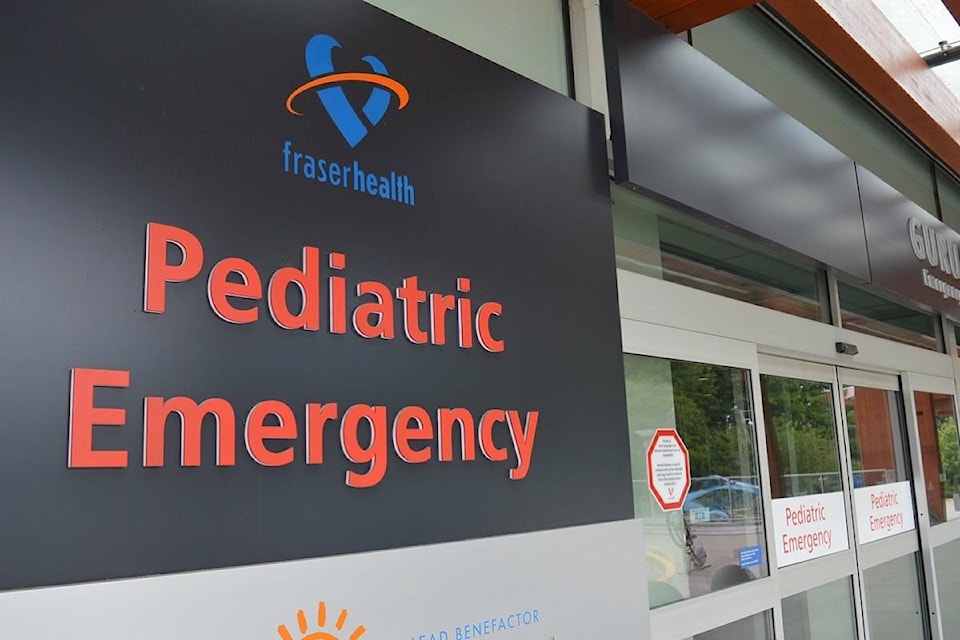You are lucky indeed if you manage to make it through your childhood without suffering at least one broken bone. For many, it’s a rite of passage.
And if your child or grandchild has taken a bad spill, and you live in Surrey, chances are you’ve headed over to the Surrey Memorial Hospital’s pediatric emergency department for help. If you were picked up by an ambulance, the paramedics might have taken you to Royal Columbian Hospital or BC Children’s Hospital if your injuries were serious. If you walk into SMH, and your injuries are serious, you may still get transferred.
Last week marked National Safe Kids Week, from June 5 to 11, with this year’s focus on “Walk, Bike, Wheel.”
According to BC Trauma Registry data for injuries sustained by children up to age 14, in 2015/16, biking mishaps led to 117 hospitalizations and 23 of those involved major injuries.
There were 57 pedestrian-related hospitalizations, 33 involving major injuries, and 28 children were hospitalized for skateboard-related injuries, three of them major.
More than 200 children in B.C. were taken to hospital with cycling, pedestrian-related and skateboard-related injuries last year, according to the Provincial Health Services Authority.
Dr. Priya Bhangoo, lead physician of Surrey Memorial Hospital’s pediatric emergency department, said while her department sees injured children “all times of the year,” there’s definitely an increase “as we head into the better weather season. Certainly as we head into summer it’s more frequent.”
“I’m afraid we don’t have any specific statistics but we definitely see the whole range, probably reflective of all emergency departments across the province,” Bhangoo said.
Bhangoo said different types injuries peak at different ages, depending on the season, “but there are so many factors that need to be taken into consideration. Biological development, social and cultural determinants.
“In pre-elementary and elementary years we tend to see the playground, trampoline and scooter injuries. Some of these are avoidable, or at least the risk can be reduced by certain measures. In the playground monkeybar injuries tend to be the highest incidents — children falling from quite a height and usually onto their elbows. We see a lot of elbow injuries and fractures.”
Clavicle injuries, too.
“The elbows tend to be the worst because those are the ones that we tend to see that often require immobilization for prolongued periods. The others we see are trampoline injuries. They tend to have lower limb, ankle injuries. Some of those are preventable in that the two main ways that children tend to get injured on those is that there are too many children on the trampoline or the enclosure is not secure, so then children bounce off and onto the ground.”
Bhangoo said scooter injuries tend to be abrasions, and head injuries. “We at Surrey see the relatively minor to moderate head injuries, but many of those can be prevented by a good-fitting helmet.”
Asked for advice for parents, she pauses. “At the elementary years it’s difficult, because at the same time you want your children to explore but at the same time you want to make them risk-aware. Obviously at that age their development and their motor control and their perception of danger and their risk-taking is at odds with one another. It’s very hard for them to appreciate what we see but they may not be able to see.”
It’s never a bad idea to play in safe playgrounds with soft ground to make for a soft landing, and make sure trampolines are enclosed.
Bhangoo said that when older children come for treatment, the injuries are often sports-related.
“Soccer injuries, a lot of ankles,” she said. Finger injuries are often related to basketball, and facial injuries, baseball.
Bicycling-related injuries tend to peak with pre-teens, and usually involve face, head and forearm injuries. Younger children tend to wear helmets, while preteens and older, not as much.
Bhangoo said safety campaigns like Safe Kids Week help reduce injuries.
Lisa Romein, manager of BC Children’s Hospital’s trauma program, agrees with Bhangoo that “This is the time of year where we begin to see more and more children in our emergency department with injuries related to bike, skateboard and scooter incidents, many of which are preventable.
“As parents we must educate ourselves and our children to be cautious but to have fun at the same time,” Romein said. “We have the ability to prevent many of these injuries from ever happening and to help ensure the warmer months are memorable for all the right reasons.”
Dr. Mariana Brussoni, an investigator with the BC Injury Research and Prevention Unit at BC Children’s Hospital, noted that some parents are reluctant to let their children go out to play for fear they will be injured.
“But the benefits of active transportation far outweigh the risks,” she added.
Brussoni is also an associate professor at UBC’s pediatrics department.
“Our research has shown that children with opportunities for active transport are physically active, gain independence and self-confidence, and build the skills they need to stay safe,” she said.
According to Pararchute Canada, a charitable organization dedicated to preventing injuries, preventable injuries are the number-one killer of Canadian children and a child dies every nine hours in Canada from a preventable injury.
Roughly 4,700 Canadian children are injured each year in “non-motorized wheeled activities” and 2,400 are injured as pedestrians.
